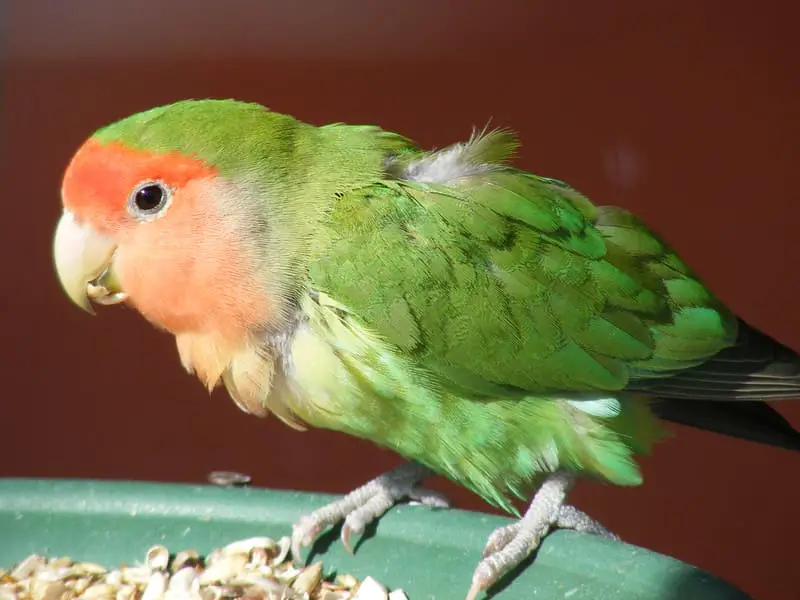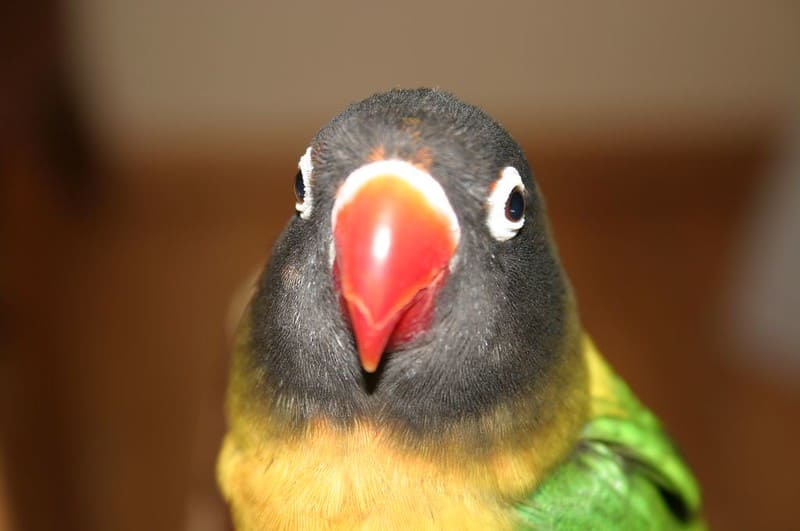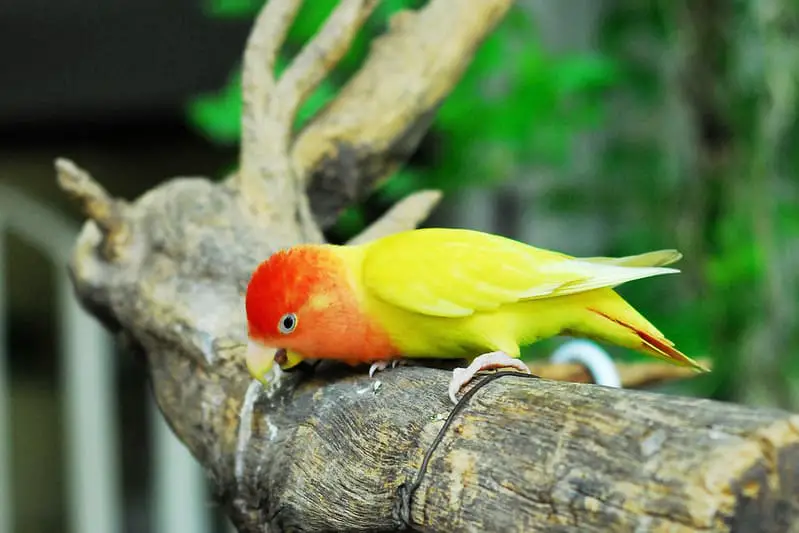Lovebirds are a captivating group of small parrots known for their vibrant plumage, charming personalities, and their strong bond with their mates. These birds are native to the African continent and are highly regarded for their striking beauty and affectionate behavior. However, the question of how many species of lovebirds exist is one that has intrigued bird enthusiasts and researchers for many years. In this article, we will explore the various species of lovebirds, their characteristics, and the ongoing debates surrounding their classification.

The Lovebird Family
Lovebirds belong to the Agapornis genus, which is part of the Psittacidae family, commonly known as the parrot family. They are a small to medium-sized parrot species, typically measuring around 13 to 17 centimeters in length, and they are known for their vibrant plumage and strong beaks. These birds are not only admired for their physical attributes but also for their unique bonding behavior. Lovebirds are famous for forming strong monogamous pairs and displaying affectionate behaviors towards their mates, which is believed to be the source of their name.
Historical Overview
The term “lovebird” is thought to have originated from the romantic and affectionate behaviors exhibited by these parrots. However, the classification of lovebirds as a group has gone through various changes over time. Initially, all lovebirds were considered to belong to a single species, the Grey-headed Lovebird (Agapornis canus). This single-species classification persisted for a long time until further research and scientific advancements revealed that lovebirds are more diverse than initially believed.
Species of Lovebirds
1. Peach-faced Lovebird (Agapornis roseicollis)
The Peach-faced Lovebird, also known as the Rosy-faced Lovebird, is one of the most popular and recognized species in the Agapornis genus. These lovebirds are known for their striking peach-colored face, vibrant green body, and distinctive blue rump. They are native to southwestern Africa, particularly in regions like Namibia and South Africa.
Peach-faced lovebirds are known for their social and affectionate behavior, both towards their mate and their human caregivers. They are excellent pets and can be easily tamed, making them a popular choice among bird enthusiasts.
2. Masked Lovebird (Agapornis personatus)
The Masked Lovebird, as the name suggests, is distinguished by its black mask-like markings on its face. These lovebirds are native to parts of Tanzania, and they come in various color mutations, such as blue, yellow, and green. They are known for their playful and mischievous nature and are often seen engaging in acrobatics and playful behaviors.
3. Fischer’s Lovebird (Agapornis fischeri)
Fischer’s Lovebirds are endemic to a small area in Tanzania and were named after the German explorer Gustav Fischer, who was instrumental in the early exploration of the region. They are characterized by their green plumage, orange face, and a blue band across their forehead. Fischer’s Lovebirds are known for their high energy levels and are among the most active and vocal of all lovebird species.
4. Lilian’s Lovebird (Agapornis lilianae)
Lilian’s Lovebirds are native to the arid regions of southwestern Africa, including parts of Namibia and Angola. They have a predominantly green plumage with a blue rump, but their distinguishing feature is the bright red forehead and a hint of red on the cheeks. They are relatively quieter than some other lovebird species and are known for their gentle and affectionate nature.
5. Nyasa Lovebird (Agapornis lilianae)
Nyasa Lovebirds, also known as Lilian’s Lovebirds, are closely related to Lilian’s Lovebirds and were initially considered a subspecies. However, recent research has led to the recognition of Nyasa Lovebirds as a separate species. They are native to the southeastern African region, specifically around Lake Malawi. Nyasa Lovebirds are characterized by their vibrant green plumage and orange face, similar to Fischer’s Lovebirds.
6. Black-cheeked Lovebird (Agapornis nigrigenis)
The Black-cheeked Lovebird is native to Zambia and central Tanzania. They are easily recognizable by their bright green plumage and distinctive black markings on their cheeks and head. Black-cheeked Lovebirds are known for their playful and curious personalities, making them delightful pets for bird enthusiasts.
7. Madagascar Lovebird (Agapornis canus)
The Madagascar Lovebird, also known as the Grey-headed Lovebird, is a species native to Madagascar. It is considered the original lovebird species, and all other lovebird species are believed to have originated from it. The Madagascar Lovebird is characterized by its grey head, green body, and red beak. It is a rare and critically endangered species, with only a few known populations in the wild.
Taxonomic Debates
The classification of lovebirds has been a topic of debate among ornithologists and taxonomists for many years. The primary reason for this ongoing debate is the extensive hybridization and interbreeding that occurs between different lovebird species in captivity. This has led to the development of numerous color mutations and hybrids that do not exist in the wild.
Furthermore, genetic studies have revealed that there is a significant amount of genetic diversity among lovebirds, even within the same species. Some researchers argue that these differences should lead to further subdivisions within the existing species, while others believe that the variations are not substantial enough to justify creating additional species.
Subspecies and Color Mutations
In addition to the debate over the number of lovebird species, there is also a complex issue regarding subspecies and color mutations. Subspecies are populations of a species that have distinct characteristics but can still interbreed with other populations of the same species. In lovebirds, subspecies are often recognized based on regional variations in color and morphology.
Color mutations, on the other hand, are variations within a species that result in birds with different colors. These mutations can occur naturally in the wild, but they are often selectively bred by aviculturists to create unique and attractive pet birds. In some cases, color mutations have been mistakenly identified as new species, further complicating the classification of lovebirds.
For example, the Fischer’s Lovebird is known to have several subspecies, each with different color variations. The Yellow-collared Lovebird (Agapornis personatus venustus) is a subspecies of the Masked Lovebird and is distinguished by its yellow collar, which is not present in the typical Masked Lovebird.
Genetic Studies
Advancements in genetic studies have shed light on the relationships among lovebirds. By examining the DNA of these birds, scientists have been able to determine the genetic relatedness among different species and subspecies. While genetic data have supported the recognition of some distinct species, it has also revealed that certain lovebirds classified as separate species are genetically very similar.
One example is the Nyasa Lovebird (Agapornis lilianae), which was initially considered a subspecies of Lilian’s Lovebird but was later elevated to species status due to genetic differences. On the other hand, the Black-cheeked Lovebird and the Peach-faced Lovebird, while visually distinct, are genetically quite similar, leading to debates about their classification.
Conservation Implications
The ongoing debates about the classification of lovebirds have implications for their conservation. Recognizing different species and subspecies is essential for understanding the genetic diversity of lovebirds in the wild and ensuring the appropriate conservation efforts are in place. It can also help in regulating the international trade of lovebirds to prevent the illegal capture and sale of endangered species.
Conservation organizations, such as the World Parrot Trust and the International Union for Conservation of Nature (IUCN), play a crucial role in advocating for the protection of lovebirds and their natural habitats. These organizations work to raise awareness about the conservation status of different lovebird species and support efforts to protect and rehabilitate wild populations.

Lovebirds in Captivity
Lovebirds have long been popular pets due to their charming personalities, small size, and vibrant plumage. They are known for their playful and social behaviors, and their strong bonding tendencies make them attractive companions for those who have the time and dedication to care for them.
Breeding and Color Mutations
One of the fascinating aspects of lovebirds in captivity is the breeding and development of color mutations. Lovebirds are known to breed readily in captivity, and aviculturists have selectively bred them to produce a wide range of color variations. Some of the most popular color mutations include lutino (yellow), albino (white), pied (irregular color patterns), and various combinations of these mutations.
The breeding of color mutations has contributed to the confusion surrounding lovebird classification, as some color mutations have been mistakenly identified as separate species. For example, the Dutch Blue Lovebird is a popular color mutation of the Peach-faced Lovebird but is not a distinct species.
Care and Husbandry
Proper care and husbandry of lovebirds in captivity are essential for their well-being. Lovebirds require spacious cages with toys and perches to keep them mentally and physically active. A balanced diet that includes a variety of seeds, fruits, vegetables, and pellets is crucial to their health.
Regular social interaction with their owners is also essential, as lovebirds are highly social birds. However, they can become territorial and may exhibit aggressive behaviors if not properly socialized from a young age. It is essential for owners to invest time in training and socializing their lovebirds to ensure they develop into well-behaved and happy pets.
Health Concerns
Like all pet birds, lovebirds are susceptible to a range of health issues. Common health concerns for lovebirds include:
- Respiratory infections: Lovebirds can develop respiratory infections if they are exposed to drafts or kept in damp conditions.
- Feather plucking: Lovebirds may engage in feather plucking if they are bored or stressed. Identifying the cause of the behavior and providing enrichment can help alleviate this issue.
- Obesity: Overfeeding and a lack of exercise can lead to obesity in lovebirds. A balanced diet and regular exercise are essential to prevent this condition.
- Beak and feather disease: This viral disease can affect lovebirds, causing feather loss and beak abnormalities. It is a highly contagious disease, and prevention is essential.
- Egg binding: Female lovebirds can experience egg binding, a condition where they are unable to lay eggs. This is a life-threatening emergency that requires immediate veterinary care.
Lifespan
Lovebirds can live for an extended period when provided with proper care. The average lifespan of a lovebird is around 10 to 15 years, although some individuals have been known to live well into their twenties with exceptional care. Lifespan can vary depending on factors such as genetics, diet, and environmental conditions.

Conservation Status
The conservation status of lovebirds varies from one species to another. Some species are relatively common and have stable populations, while others are critically endangered and at risk of extinction. The major threats to lovebirds in the wild include habitat destruction, illegal trapping for the pet trade, and competition with introduced species.
Endangered Species
Several lovebird species are classified as endangered or critically endangered by the IUCN. The Madagascar Lovebird (Agapornis canus) is one such species. Its habitat in Madagascar has been significantly reduced, primarily due to deforestation, which has led to a drastic decline in the wild population. Conservation efforts are underway to protect the remaining individuals and their habitat.
Another example is the Black-cheeked Lovebird (Agapornis nigrigenis), which is native to Zambia and central Tanzania. This species faces threats from habitat loss and capture for the pet trade. Its small population and limited distribution make it particularly vulnerable to extinction.
Conservation Efforts
Conservation organizations, along with local governments and communities, play a crucial role in protecting lovebirds and their habitats. Efforts include habitat preservation, enforcement of laws against illegal trapping and trade, and community education to promote coexistence with lovebirds and other wildlife.
One successful conservation project is the Rosy-faced Lovebird Recovery Project in Namibia. This initiative aims to protect the Peach-faced Lovebird (Agapornis roseicollis), which is native to the region. By working with local communities and promoting ecotourism, the project has contributed to the conservation of this lovebird species.
Captive Breeding and Reintroduction
Captive breeding programs are another important tool in the conservation of lovebirds. These programs aim to breed lovebirds in controlled environments and then release them into the wild to bolster wild populations. This strategy has been successful in increasing the numbers of some endangered lovebird species.
An example of this is the Black-cheeked Lovebird Conservation Project, which focuses on breeding and releasing Black-cheeked Lovebirds into their natural habitat in Zambia. This project has played a significant role in the recovery of the species.
Conclusion
Lovebirds are a remarkable group of parrots known for their striking beauty and affectionate behaviors. The classification of lovebirds has been a subject of ongoing debate due to the extensive hybridization, color mutations, and genetic diversity among the different species and subspecies. While there is no definitive consensus on the exact number of lovebird species, it is clear that these birds are highly diverse and deserving of protection.
Conservation efforts are essential to ensure the survival of endangered lovebird species and to preserve their natural habitats. It is crucial to address the threats these birds face, including habitat destruction and illegal trapping for the pet trade. Through collaboration between conservation organizations, local communities, and governments, there is hope that lovebirds will continue to enchant us with their vibrant colors and charming personalities in the wild for generations to come.
